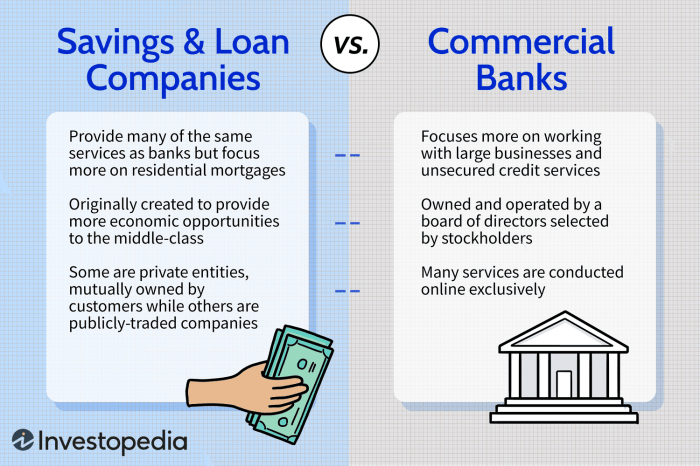Defining Private Finance Corporations (PFCs) in Commercial Lending

Private finance corporations (PFCs) represent a significant segment of the commercial lending market, offering alternative financing solutions to businesses that may not qualify for or prefer traditional bank loans. They differ substantially from banks in their operational structure, investment strategies, and regulatory oversight. Understanding these distinctions is crucial for businesses seeking financing and for investors considering this asset class.PFCs operate outside the traditional banking system, often focusing on niche markets or higher-risk ventures.
This allows them to offer more flexible financing options and cater to borrowers with specific needs.
Key Characteristics Distinguishing PFCs from Traditional Banks in Commercial Lending
PFCs are characterized by their non-bank status, leading to several key differences compared to traditional banks in commercial lending. They typically have a less stringent lending process, focusing on the potential of the business rather than solely on collateral or credit scores. Furthermore, PFCs frequently offer customized financing solutions tailored to individual business needs, unlike banks which often rely on standardized loan products.
Their decision-making processes are often quicker and more flexible, enabling faster loan approvals. Finally, PFCs may have a higher tolerance for risk compared to banks, leading them to invest in companies that banks might deem too risky.
Typical Investment Strategies and Risk Profiles of PFCs Involved in Commercial Loans
PFC investment strategies vary widely depending on their specific focus and target market. Some PFCs might specialize in providing mezzanine financing, bridging the gap between debt and equity. Others may focus on providing senior secured loans, offering lower risk but potentially lower returns. Still others may invest in distressed debt, seeking opportunities to acquire assets at a discount.
This range of strategies translates to a diverse risk profile, with some PFCs accepting higher risk for potentially higher returns, while others prioritize lower risk and more predictable returns. For instance, a PFC specializing in distressed debt will naturally accept a higher risk profile compared to one focusing on senior secured loans. The risk is directly correlated to the expected return, creating a risk-return trade-off inherent in their investment approach.
Regulatory Frameworks Governing PFCs and Traditional Banks
The regulatory frameworks governing PFCs and traditional banks differ significantly. Traditional banks are subject to stringent regulations enforced by bodies such as the Federal Reserve (in the US) or equivalent institutions in other countries. These regulations cover aspects such as capital adequacy, liquidity, and risk management. PFCs, on the other hand, often face less stringent regulatory oversight, though the level of regulation varies considerably depending on their structure, the type of financing they offer, and the jurisdiction in which they operate.
This difference in regulation impacts the level of transparency and reporting requirements for each entity.
Examples of Different Types of PFCs and Their Respective Lending Specializations
Several types of PFCs exist, each with its own lending specialization. For example, private equity firms often provide leveraged buyouts and growth capital to companies, while venture capital firms focus on early-stage companies with high growth potential. Hedge funds might engage in distressed debt investing, purchasing debt securities at a discount, while specialized finance companies may focus on niche sectors like real estate or equipment financing.
These different specializations lead to variations in their lending criteria, terms, and risk appetites. A venture capital firm, for instance, will likely prioritize innovative companies with high growth potential, even if they lack a strong track record, whereas a real estate finance company will focus on the value and location of the property being financed.
Loan Products Offered by PFCs

Private finance corporations (PFCs) offer a diverse range of commercial loan products tailored to meet the specific needs of businesses of varying sizes and industries. These products often provide financing options that may not be readily available through traditional banks, catering to businesses with unique financial profiles or specific requirements. The flexibility and speed of PFC lending are key differentiators.
PFCs typically assess risk and creditworthiness on a case-by-case basis, considering factors beyond traditional credit scores. This allows them to provide financing to businesses that might be considered higher-risk by traditional lenders, potentially opening up access to capital for companies that otherwise might struggle to secure funding.
Types of Commercial Loans Offered by PFCs
Private finance corporations provide a variety of financing solutions. The specific offerings can vary depending on the PFC’s investment strategy and risk appetite. However, some common loan structures are detailed below.
| Loan Type | Description | Typical Borrower | Key Features |
|---|---|---|---|
| Term Loans | A lump-sum loan repaid in regular installments over a fixed period. | Established businesses with consistent revenue streams needing capital for expansion, equipment purchases, or refinancing. | Fixed interest rate, predictable repayment schedule, suitable for long-term projects. |
| Lines of Credit | A revolving credit facility allowing businesses to borrow and repay funds as needed up to a pre-approved limit. | Businesses with fluctuating cash flow needing flexible access to capital for operational expenses or seasonal demands. | Flexible borrowing and repayment, variable interest rate, ongoing access to funds. |
| Asset-Based Lending | Loans secured by a company’s assets, such as inventory, accounts receivable, or equipment. | Businesses with significant assets but limited credit history or facing financial challenges. | Higher loan amounts possible, lower interest rates compared to unsecured loans, requires collateral. |
| Bridge Loans | Short-term loans used to bridge a gap in financing, often used to cover expenses until longer-term financing is secured. | Businesses needing temporary funding for acquisitions, refinancing, or short-term projects. | Short repayment period, higher interest rates than longer-term loans. |
| Mezzanine Financing | A hybrid form of financing that combines debt and equity features, often used for leveraged buyouts or expansion projects. | Companies seeking significant capital injections for growth, often with a higher risk profile. | Higher risk, higher potential returns, involves equity participation or warrants. |
Loan Terms and Conditions
The specific terms and conditions of a PFC loan will vary based on factors such as the borrower’s creditworthiness, the loan amount, the type of loan, and the prevailing market conditions. However, some common elements include:
Interest Rates: Interest rates charged by PFCs are generally higher than those offered by traditional banks due to the higher perceived risk. These rates can be fixed or variable, depending on the loan structure and market conditions. For example, a term loan might have a fixed rate, offering predictability for the borrower, while a line of credit may have a variable rate tied to a benchmark interest rate like LIBOR (or its successor).
Repayment Schedules: Repayment schedules are tailored to the specific loan and the borrower’s capacity. Term loans typically have fixed monthly or quarterly payments, while lines of credit allow for more flexible repayment based on usage. Specific details will be Artikeld in the loan agreement.
Covenants: Loan agreements often include covenants, which are conditions the borrower must meet throughout the loan term. These covenants might include maintaining certain financial ratios, providing regular financial statements, or adhering to specific operating practices. Failure to meet these covenants can result in default.